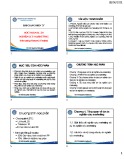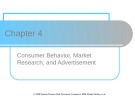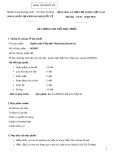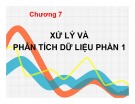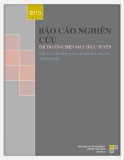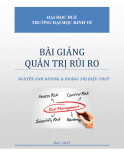Marketing Research
Primary vs. secondary data Advantages and disadvantages of each
Marketing research tools
MKTG 370 MARKETING RESEARCH Lars Perner, Instructor 1
Marketing Research
An “investment” to reduce uncertainty Can help guide decisions on Whether to enter Product
characteristics
Must weigh costs and benefits of research Money Time spent No perfect method— tradeoffs between methods
Promotional strategy Positioning
MKTG 370 MARKETING RESEARCH Lars Perner, Instructor 2
Two Research Methods
Secondary: use of existing research already done Government Consulting firms Newspaper and magazine
articles
Primary: creation of specific studies to answer specific questions
MKTG 370 MARKETING RESEARCH Lars Perner, Instructor 3
Some Sources of Secondary Data
U.S. Governent http://StatUSA.gov
Government Department
Trade organizations Consultants E.g., Information
web sites
Resources International (IRI), Nielsen
Government periodicals
in libraries
E.g., Statistical
Be weary of web sites Company sites are
glorified advertisements!
Anyone can publish a
web site.
Abstracts Books, periodicals, newspapers
MKTG 370 MARKETING RESEARCH Lars Perner, Instructor 4
Primary Research Methods
Surveys Experimentation Observation Focus groups Indepth interviews Projective techniques Physiological Measures
MKTG 370 MARKETING RESEARCH Lars Perner, Instructor 5
Surveys
Problem questions Leading Ambiguous Unanswerable Two questions in one Nonexhaustive question Nonmutually exclusive
answers
Planned questions Openended Closedended Need large sample sizes for precise conclusions Forms Mail Telephone Mall Intercept Computer/Internet
MKTG 370 MARKETING RESEARCH Lars Perner, Instructor 6
The Pentagon Declares War on Rush Limbaugh: Misleading Research
Survey found that only 4.8% of listeners to the Armed Forces Radio Network wanted to listen to “the biggest hawk there is.” How could a survey be made to get these results? Being on the watch for misleading surveys.
MKTG 370 MARKETING RESEARCH Lars Perner, Instructor 7
Experimentation
Subjects in different groups treated differently E.g., for some, “target” product is given better shelf space
E.g., some get coupon Can help isolate causes Subject is biased by questions—does not know how others are treated
MKTG 370 MARKETING RESEARCH Lars Perner, Instructor 8
My Simulated Store…
A shopper in the everyday low price condition…
MKTG 370 MARKETING RESEARCH Lars Perner, Instructor 9
Observation
Looking at consumes in the field—e.g., Searching for product category
area
Number of products inspected
and time spent on each
Involvement of others Behavior under limiting
circumstances (e.g., time constraints)
MKTG 370 MARKETING RESEARCH Lars Perner, Instructor 10
Focus Groups
Groups of 812 consumers assembled Start out talking generally about context of product Gradually focus in on actual product
MKTG 370 MARKETING RESEARCH Lars Perner, Instructor 11
Indepth interviews
Structured vs. unstructured interviews Generalizing to other consumers Biases
MKTG 370 MARKETING RESEARCH Lars Perner, Instructor 12
Projective Techniques
Measurement of attitudes consumers are unwilling to express Consumer discusses what other consumer might think, feel, or do
MKTG 370 MARKETING RESEARCH Lars Perner, Instructor 13
Scanner Data
“Household Panel” members agree to present card at purchase to link demographics and media exposure Possible to correlate conditions with purchases made: Demographics Exposure to advertising; number of
exposures
Sales promotion, premium, special display,
special conditions for competing brand
Past purchasing behavior
MKTG 370 MARKETING RESEARCH Lars Perner, Instructor 14













